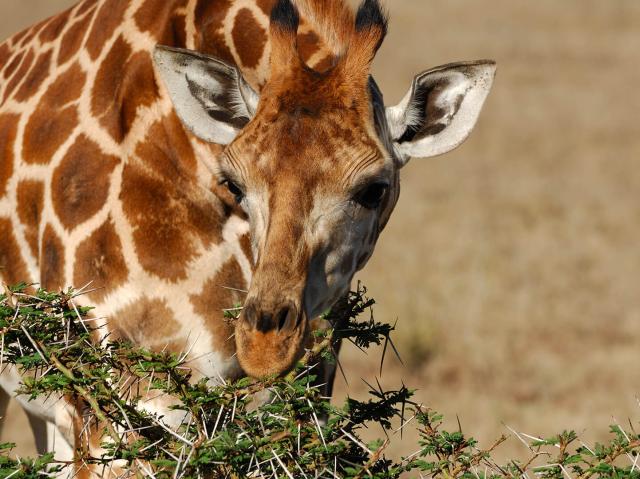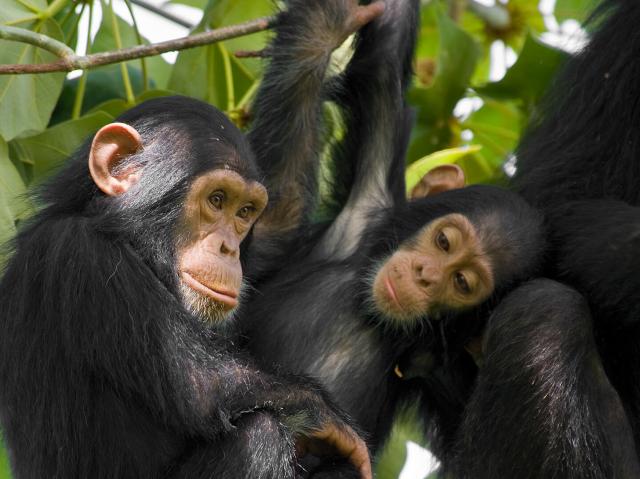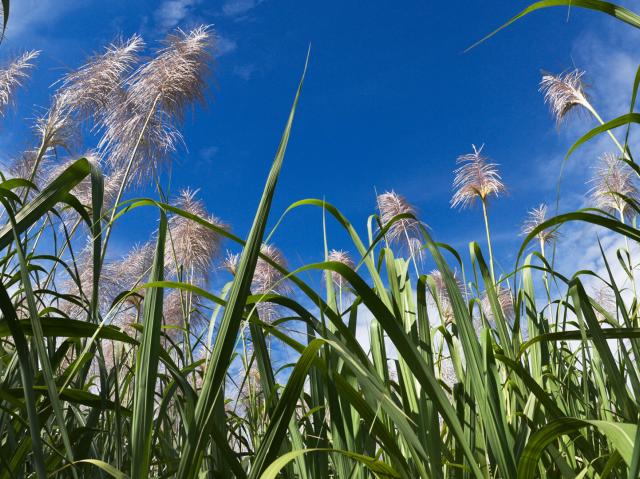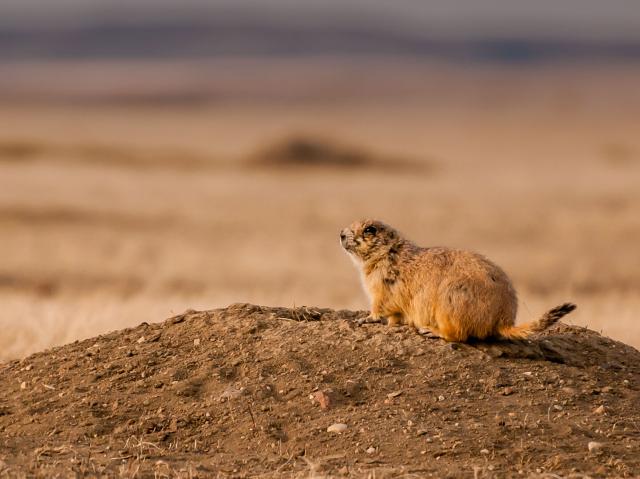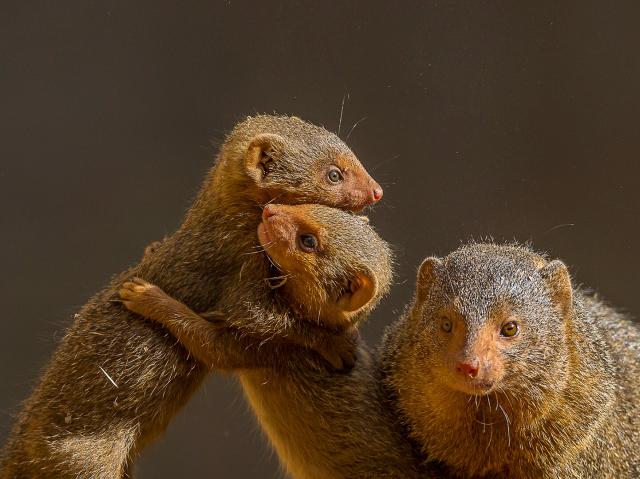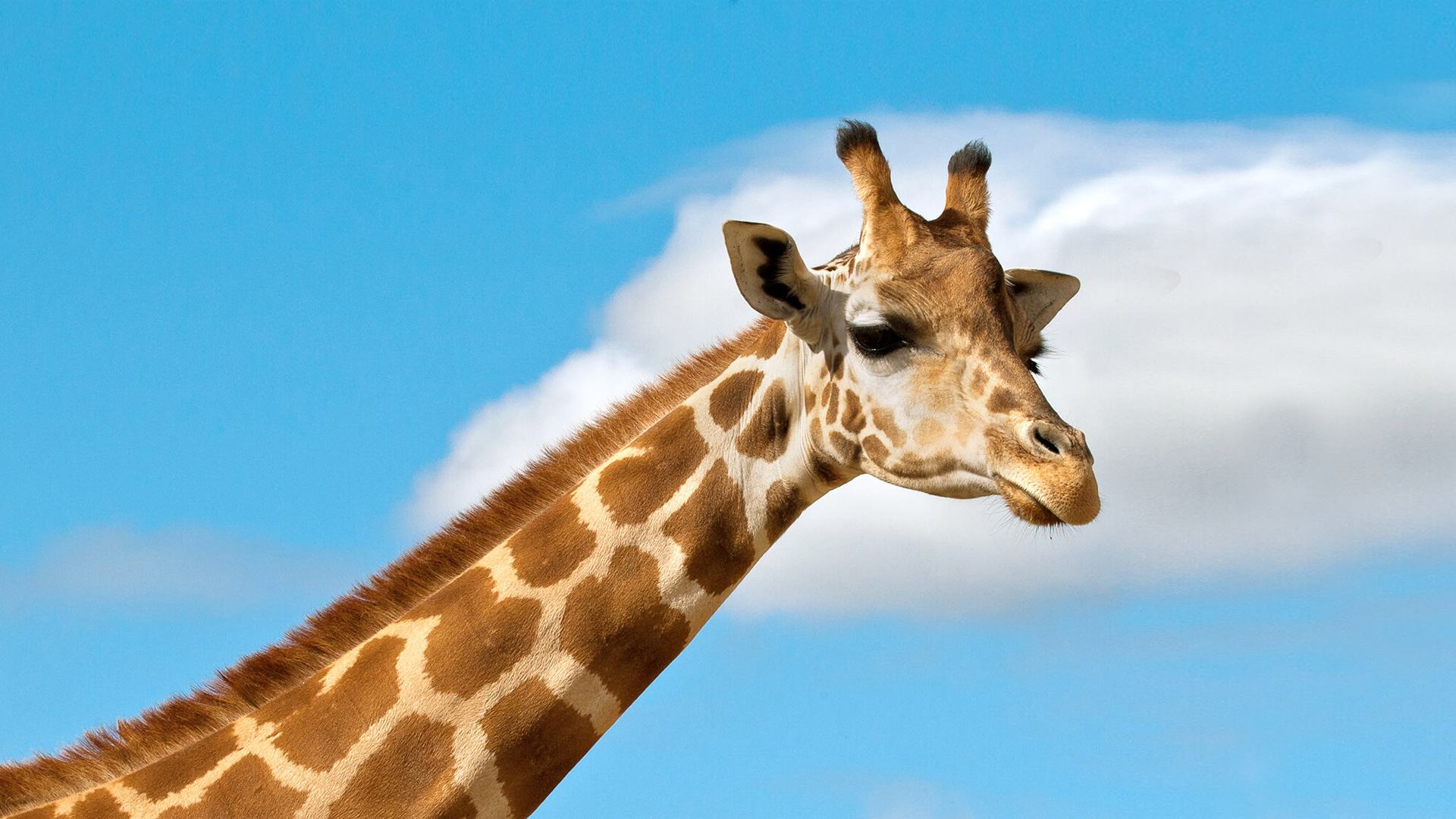
Giraffe

- CLASS: Mammalia (Mammals)
- ORDER: Artiodactyla
- FAMILY: Giraffidae
- GENUS: Giraffa
- SPECIES: camelopardalis

ABOUT
Hello up there! Why do so many people look up to giraffes—besides the obvious reason? The long and short of it is that they are a wonderful example of nature’s creativity.
Giraffes are the tallest land animals. A giraffe could look into a second-story window without even having to stand on its tiptoes! A giraffe's 6-foot (1.8-meter) neck weighs about 600 pounds (272 kilograms). The legs of a giraffe are also 6 feet (1.8 meters) long. The back legs look shorter than the front legs, but they are about the same length. A giraffe's heart is 2 feet (0.6 meters) long and weighs about 25 pounds (11 kilograms), and its lungs can hold 12 gallons (55 liters) of air! Its closest relative is the okapi.
Giraffes have a small hump on their back and have a spotted pattern similar to that of a leopard. For a long time people called the giraffe a “camel-leopard,” because they believed that it was a combination of a camel and a leopard. That's where the giraffe's name camelopardalis comes from!
Although a study of giraffe genetics published in the scientific journal Current Biology concluded that there are actually four distinct species of giraffes—said to be as different from each other as polar bears are from brown bears—one is currently recognized, with nine subspecies. The subspecies have different coat patterns and live in different parts of Africa. Giraffe coat colors vary from light tan to practically black. The differences occur due to what the giraffes eat and where they live. Each individual giraffe’s markings are as individual as our fingerprints.
Masai giraffes, from Kenya, have patterns that look like oak leaves. Uganda or Rothschild's giraffes sport large, brown splotches separated by thick, beige lines. The reticulated giraffe, found only in northern Kenya, has a dark coat with a seeming web of narrow white lines.
How many bones are there in a giraffe's neck? Just like humans, giraffes have seven neck vertebrae. For giraffes, however, each one can be over 10 inches (25.4 centimeters) long!
Both male and female giraffes have two distinct, hair-covered horns called ossicones. Male giraffes use their horns to spar, throwing their neck against each other. As a male matures, calcium deposits begin to form on his skull to protect it when he head-butts with other males. These calcifications can be quite pronounced, giving the strange appearance of a three- to five-horned giraffe.
Giraffes are so big that they really don't need to hide from predators. There is safety in numbers! It’s hard to pick out one giraffe from another when they form a tight group.
Besides humans, only lions and crocodiles hunt them. If they have to, giraffes defend themselves with a deadly kick, karate-style. Their speed, the way they move, and their body designs also help them to escape predators if they need to. Giraffes have a way of moving, or gait, in which both the front and back legs on one side move forward together, then the other two legs on the other side move forward. It’s called "pacing." Giraffes can run very fast—around 35 miles (56 kilometers) per hour for short distances.
You might think watching out for lions and spending 16 to 20 hours a day eating would all weigh heavily on a giraffe. Surprisingly enough, giraffes only need 5 to 30 minutes of sleep in a 24-hour period! They often achieve that in quick naps that may last only a minute or two at a time. Giraffes can rest while standing, but they sometimes also lie down with their head resting on their rump. That’s a vulnerable position for a giraffe, though, so usually one herd member stays on guard.
Many people think that giraffes have no voice, but they do make a variety of sounds, including moos, roars, snorts, hisses, and grunts. They just very rarely do so. One sound giraffes make when they’re alarmed is a snort. Threats—such as lions nearby—may warrant a snort. Giraffes are often the early warning signal for other savanna wildlife: if a giraffe herd starts to run, everyone else does, too! Studies suggest giraffes vocalize below the level of human hearing and perhaps use this sound for long-distance communication.
It’s easy to understand why giraffes top the list of so many people’s favorite wildlife. Their elegant stride, outrageous eyelashes, and calm expression give them an air of refinement.
HABITAT AND DIET
Blending right in: In a zoo, giraffes stand out. But think of giraffes' presence in their African habitat, where their coat patterns actually serve as camouflage, blending with shadows and leaves. Giraffes are well adapted for living on the open, tree-dotted African plains. While other African herbivores compete for grass and small plants to eat, giraffes have the high branches with tender, young leaves all to themselves.
It takes a lot of leaves to fuel such large creatures. Giraffes may eat up to 75 pounds (34 kilograms) of food per day. They spend most of their day eating, because they get just a few leaves in each bite. Their favorite leaves are from acacia trees. These trees have long thorns that keep most wildlife from eating them. But those thorns don't stop the giraffes! They simply use their 18-inch (46-centimeter) tongue and prehensile lips to reach around the thorns. It is thought that the dark color of their tongue protects them from getting sunburned while reaching for leaves. Giraffes also have thick, sticky saliva that coats any thorns they might swallow.
Giraffes are ruminants and have a stomach with four compartments that digests the leaves they eat. When giraffes aren't eating, they're chewing their cud. After giraffes swallow the leaves the first time, a ball of leaves travels all the way back up the throat into the mouth for more grinding.
Acacia leaves contain a lot of water, so giraffes can go a long time without drinking. When they do get thirsty, giraffes have to bend a long way down to drink from a lake or stream. When they're bent over, it is easier for a predator, like a crocodile, to grab hold of the giraffe. So, giraffes go to a watering hole together and take turns watching for predators. If water is easily available, they can drink 10 gallons (38 liters) a day.
FAMILY LIFE
When a giraffe baby, called a calf, is born, it comes into the world front feet first, followed by the head, neck, and shoulders. Its entry is like a slow-motion swan dive! Because the umbilical cord is only about 3 feet (1 meter) long, it breaks midway through the birth, allowing the newborn to drop to the ground. The fall and the landing don't hurt the calf, but they do cause it to take a big breath. The calf can stand up and walk after about an hour, and within a week, it starts to sample vegetation. Sometimes the mother leaves the calf alone for most of the day. The youngster sits quietly until she returns.
When a calf gets older, the mother leaves her youngster together with other calves in a "nursery." One of the moms stays to babysit while the others go out to eat and socialize. In the nursery, the calves develop physical and social skills through play. Under the watchful eye of the designated babysitter, the youngsters explore their surroundings throughout the day. The young giraffes can eat leaves at the age of four months, but continue to nurse until they are six to nine months old.
CONSERVATION
In many African countries, giraffe populations are slowly decreasing because of habitat loss and the overgrazing of resources by livestock. As a result, the future of giraffes is dependent on the quality of the habitat that remains. Their numbers have decreased in the past century—one giraffe subspecies, the West African or Nigerian giraffe Giraffa camelopardalis peralta, is vulnerable; and another, the Uganda or Rothschild’s giraffe G.c. rothschildi, is near threatened. While it has historically lived in western Kenya, Uganda, and southern Sudan, the Uganda giraffe has been almost totally eliminated from most of its former range and now survives in only a few small, isolated populations in Kenya and Uganda. The Nigerian giraffe is found in just one area of Niger, and it is considered the rarest of the giraffes.
The population of reticulated giraffes G.c. reticulata has dropped by an alarming 80 percent in just 10 years, most likely due to poaching. They are no match for humans with guns; giraffes are shot or snared for their meat, hide, bone marrow, and tail hair. Kenya is starting a giraffe conservation program for the three subspecies found there: reticulated, Uganda, and Masai giraffes G.c. tippelskirchi.
San Diego Zoo Wildlife Alliance supports a community conservation effort in northern Kenya that is finding ways for people and wildlife to live together. By supporting San Diego Zoo Wildlife Alliance, you are our ally in saving and protecting wildlife worldwide.
LIFE SPAN
15 to 20 years
YOUNG
Gestation: 14 months
Number of young at birth: Usually 1
Height at birth: 6 feet (1.8 meters)
Weight at birth: 100 to 220 pounds (45 to 100 kilograms)
Age of maturity: 3 to 5 years
SIZE
Height: Females, up to 14 feet (4.3 meters); males, up to 18 feet (5.5 meters)
Weight: Females, up to 1,500 pounds (680 kilograms); males, up to 3,000 pounds (1,360 kilograms)
FUN FACTS
A giraffe's feet are the size of a dinner plate—12 inches across (30.5 centimeters).
The record running speed of a giraffe is 34.7 miles per hour (56 kilometers per hour).
A giraffe’s eyes are the size of golf balls.
Giraffe calves grow 1 inch (2.54 centimeters) each day during their first week.



